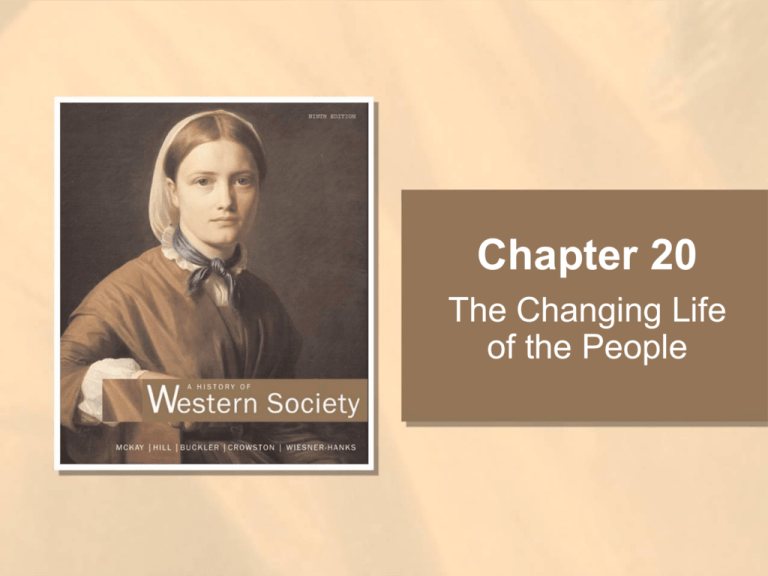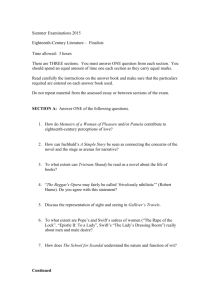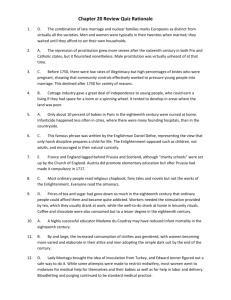The Changing Life of the People
advertisement

Chapter 20 The Changing Life of the People A quack doctor uses a snake and a dog to sell a miraculous cure-all in an Italian village market, A quack doctor uses a snake and a dog to sell a miraculous cure-all in an Italian village market, in a painting (detail) by Michele Graneri (1736–1778). Dagli Orti/Private Collection/The Art Archive Boucher: The Pretty Cook Increased migration to urban areas in the eighteenth century contributed to a loosening of traditional morals and soaring illegitimacy rates. Young women who worked as servants or shop girls could not be supervised as closely as those who lived at home. The themes of seduction, fallen virtue, and familial conflict were popular in eighteenth-century art, such as this painting by François Boucher (1703–1770), master of the rococo. Réunion des Musées Nationaux/Art Resource, NY Arrival of the Wet Nurses Wet-nursing was big business in eighteenth-century France, particularly in Paris and the north. Here, rural wet nurses bring their charges back to the city to be reunited with their families after around two years of care. These children were lucky survivors of a system that produced high mortality rates. Réunion des Musées Nationaux/Art Resource, NY Cultivating the Joy of Discovery This English painting by Joseph Wright of Derby (1734–1797) reflects new attitudes toward child development and education, which advocated greater freedom and direct experience. The children rapturously watch a planetarium, which illustrates the movements and positions of the planets in the solar system. Wise teachers stand by, letting the children learn at their own pace. Derby Museum & Art Gallery/The Bridgeman Art Library Literacy in France on the Eve of the French Revolution Literacy rates increased but still varied widely between and within states in eighteenth century Europe.•1 What trends in French literacy rates does this map reveal? Which regions seem to be ahead? How would you account for the regional variations?•2 The map is based on the percentage of bridegrooms able to sign their names at marriage. Who is missing from the map? How do you think literacy rates may have varied for people not covered by this source?•3 Note the areas marked “unknown." Why do you think historians do not know the literacy rates for those areas? What alternate methods might they use to find this information? Raoux: Young Woman Reading a Letter Literacy rates for men and women rose substantially during the eighteenth century. The novel also emerged as a new literary genre in this period. With its focus on emotions, love, and family melodrama, the novel was seen as a particularly feminine genre, and it allowed women writers more access to publication. Writing and reading letters were also associated with women. Some contemporaries worried that women’s growing access to reading and writing would excite their imagination and desires, leading to moral dissolution. Réunion des Musées Nationaux/Art Resource, NY Royal Interest in the Potato Frederick the Great of Prussia, shown here supervising cultivation of the potato, used his influence and position to promote the new food on his estates and throughout Prussia. Peasants could grow potatoes with the simplest hand tools, but it was backbreaking labor, as this painting by R. Warthmüller suggests. Private Collection, Hamburg/akg-images The Fashion Merchant’s Shop Shopping in fancy boutiques became a favorite leisure pastime of the rich in the eighteenth century. Whereas shops had previously been dark, cramped spaces, now they were filled with light from large plate-glass windows, staffed by finely dressed attendants, and equipped with chairs and large mirrors for a comfortable shopping experience. Fashion merchants (or milliners) sold hats, shawls, parasols, and an infinite variety of accessories and decorations. Courtesy, University of Illinois Library An Eighteenth-Century Pharmacy In this lively painting a woman consults an apothecary (in the elegant red suit) while his assistants assemble drugs for new prescriptions. By 1700 apothecaries had emerged as a separate group of state licensed medical professionals. They drew on published lists and books describing the properties and dosages of their concoctions, but there were many different “recipes” |and trade secrets. Civico Museo Bibliograco Musicale, Bologna, Italy/ The Bridgeman Art Library Hospital Life Patients crowded into hospitals like this one in Hamburg in 1746 had little chance of recovery. A priest by the window administers last rites, while in the center a surgeon coolly saws off the leg of a man who has received no anesthesia. Germanisches Nationalmuseum, Nuremberg Hogarth’s Satirical View of the Church William Hogarth (1697–1764) was one of the foremost satirical artists of his day. This image mocks a London Methodist meeting, where the congregation swoons in enthusiasm over the preacher’s sermon. The woman in the foreground giving birth to rabbits refers to a hoax perpetrated in 1726 by a servant named Mary Tofts; the credulousness of those who believed Tofts is likened to that of the Methodist congregation. HIP/Art Resource, NY Procession of Nuns at Port-Royal des Champs The convent of Port-Royal, located twenty miles southwest of Paris, was a center of Jansenist activity throughout the seventeenth century. Angered by the nuns’ defiance, Louis XIV ordered them forcibly relocated in 1709. To generate support, the artist Magdelaine Horthemels painted a series of images depicting the pious and placid religious life at the convent. The convent was nonetheless destroyed by Louis’s forces in 1710. This image is one of many copies of Horthemels’ work made by Jansenists in the eighteenth century. Réunion des Musées Nationaux/Art Resource, NY Cockfighting in England This engraving by William Hogarth (see also the illustration on page 673) satirizes the popular taste for blood sports, which Hogarth despised and lampooned in his famous Four Stages of Cruelty. The central figure in the wildly excited gathering is a blind nobleman who actually existed and seldom missed a fight. Note the steel spurs on the birds’ legs. Courtesy of the Trustees of the British Museum







